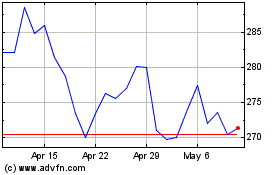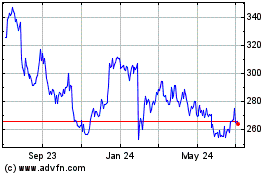U.S. Industrial Production Flat in October
November 16 2016 - 10:10AM
Dow Jones News
WASHINGTON—Industrial output was flat in October as unusually
warm weather depressed demand for home and office heating, but the
U.S. manufacturing and mining sectors showed continued signs of
stabilization.
Industrial production—a measure of output from America's
factories, power plants and mines—was unchanged on a seasonally
adjusted basis in October from the prior month, the Federal Reserve
said Wednesday. Economists surveyed by The Wall Street Journal had
expected a 0.2% increase.
Production fell 0.2% in September, revised down from an
initially estimated 0.1% rise. Output had dropped 0.1% in August,
revised up from an earlier estimate of a 0.5% decline.
Utilities production dropped sharply in October and September,
offsetting modest gains in factory output. Mining production surged
last month at the fastest pace in 2½ years.
Total production fell 0.9% over the past year.
Capacity utilization, a gauge of slack in the industrial
economy, ticked down 0.1 percentage point to 75.3% last month.
Economists had expected an October reading of 75.5%.
In October, output rose 0.2% from the prior month in the
manufacturing category, matching its September increase. Still,
factory production was down 0.2% last month from a year
earlier.
Utilities production was down 2.6% in October after falling 3.0%
in September. The Fed said "warmer-than-normal temperatures reduced
the demand for heating." It was the warmest October since 1963
across the 48 contiguous U.S. states and the third-warmest October
on record, according to the National Oceanic and Atmospheric
Administration.
Mining production jumped 2.1% in October, the largest gain since
March 2014. The Fed said gains for coal mining outweighed declines
in oil and gas extraction. Still, mining output remained down 7.0%
from a year earlier.
The U.S. industrial economy has appeared to stabilize in recent
months following two years of pressure from a strong dollar, which
dampened demand for U.S. exports, and low oil prices that squeezed
the domestic energy industry.
The Institute for Supply Management's closely watched gauge of
manufacturing activity signaled expansion in October for the second
straight month, and the index has indicated rising factory activity
in seven of the past eight months. In addition, the number of
active U.S. oil rigs has been rising since the summer, according to
oil-field services company Baker Hughes Inc.
"Oil and commodity prices have somewhat recovered, and our
business in heavy-industry markets generally appears to have
stabilized," said Blake Moret, chief executive at Rockwell
Automation Inc., on a call with analysts last week. "Current
forecasts call for improved global GDP and industrial production
growth rates, as well as higher levels of global capital
expenditures. We therefore expect improvement to continue."
But soft spots persist across the economy. Matt Farrell, chief
executive at consumer-goods manufacturer Church & Dwight Co.,
told analysts earlier this month that while unemployment is steady,
overall growth has been slow and families are facing rising
health-care costs.
"I wouldn't say it's the best outlook for the consumer," he
said.
Broader U.S. economic growth picked up over the summer after a
slow start to the year, with gross domestic product expanding at an
inflation-adjusted annual rate of 2.9% in the third quarter,
according to the Commerce Department. The outlook for the final
three months of 2016 is uncertain. Forecasting firm Macroeconomic
Advisers on Tuesday predicted GDP growth at a 1.8% pace in the
fourth quarter, while the Federal Reserve Bank of Atlanta's GDPNow
model projected a 3.3% growth rate.
Stronger growth in the second half of the year could boost the
odds of a rate increase by the Federal Reserve at its Dec. 13-14
policy meeting, already seen as likely by private economic
forecasters and financial markets. The central bank's benchmark
short-term interest rate has been set at a range of 0.25% to 0.5%
since last December.
"Absent significant negative economic news over the next month,
the market's assessment of the likelihood of tightening in December
seems plausible," Federal Reserve Bank of Boston President Eric
Rosengren said Tuesday.
Wednesday's report reflected industrial conditions ahead of last
week's U.S. presidential election.
Write to Ben Leubsdorf at ben.leubsdorf@wsj.com and Jeffrey
Sparshott at jeffrey.sparshott@wsj.com
(END) Dow Jones Newswires
November 16, 2016 09:55 ET (14:55 GMT)
Copyright (c) 2016 Dow Jones & Company, Inc.
Rockwell Automation (NYSE:ROK)
Historical Stock Chart
From Mar 2024 to Apr 2024

Rockwell Automation (NYSE:ROK)
Historical Stock Chart
From Apr 2023 to Apr 2024
